I'm running through a weird problem. Basically I have Mesh class depending on a flag, I can draw a point, a line, or a triangle. For example, if I want to draw two lines, I can do the following
Vertex vertices1[] = {
Vertex(glm::vec3(-.5, -.5, 0)),
Vertex(glm::vec3( 0, .5, 0))
};
Vertex vertices2[] = {
Vertex(glm::vec3( .5, -.5, 0)),
Vertex(glm::vec3( -.5, .5, 0))
};
Mesh mesh1(vertices1, sizeof(vertices1)/sizeof(vertices1[0]), 'L');
Mesh mesh2(vertices2, sizeof(vertices2)/sizeof(vertices2[0]), 'L');
// Rendering Loop:
while( Window.isOpen() ){
...
//================( Rendering )=========================
ourShader.Use();
mesh1.draw();
mesh2.draw();
//======================================================
...
}
The result is
Now I would like to use std::vector<Mesh> and loop through meshes. My attempt is as follows
std::vector<Mesh> meshes;
meshes.push_back(mesh1);
meshes.push_back(mesh2);
while( Window.isOpen() ){
...
//================( Rendering )=========================
ourShader.Use();
for ( int i(0); i < meshes.size(); ++i )
meshes[i].draw();
//======================================================
...
}
With the preceding approach, only the last line is drawn and this is the result
Moreover, once I use .push_back() even if I don't loop through the vector, the last line is drawn. I don't understand why using std::vector deteriorates the rendering. I even tried meshes[0].draw() but with no luck. Any suggestions?
Edit: This is the constructor of Mesh class
#include <iostream>
#include <vector>
#include <glm/glm.hpp>
#include <GL/glew.h>
#include <GLFW/glfw3.h>
#include "display.h"
#include "keyboard.h"
#include "shader.h"
class Vertex
{
public:
Vertex(const glm::vec3& p) : m_position(p)
{}
private:
glm::vec3 m_position;
};
class Mesh
{
public:
Mesh(Vertex* vertices, unsigned int numVertices, const char& flag);
~Mesh();
void draw();
private:
enum{
POSITION_VB,
NUM_BUFFERS
};
GLuint m_vertexArrayObject;
GLuint m_vertexArrayBuffers[NUM_BUFFERS];
unsigned int m_drawCount;
char m_flag;
};
Mesh::Mesh(Vertex* vertices, unsigned int numVertices, const char& flag) : m_flag(flag), m_drawCount(numVertices)
{
glGenVertexArrays(1, &m_vertexArrayObject);
glBindVertexArray(m_vertexArrayObject);
glGenBuffers(NUM_BUFFERS, m_vertexArrayBuffers);
glBindBuffer(GL_ARRAY_BUFFER, m_vertexArrayBuffers[POSITION_VB]);
glBufferData(GL_ARRAY_BUFFER, numVertices*sizeof(vertices[0]), vertices, GL_STATIC_DRAW);
glEnableVertexAttribArray(0);
glVertexAttribPointer(0, 3, GL_FLOAT, GL_FALSE, 0, 0);
glBindVertexArray(0);
}
Mesh::~Mesh()
{
glDeleteVertexArrays(1, &m_vertexArrayObject);
glDeleteBuffers(1, m_vertexArrayBuffers);
}
void Mesh::draw()
{
switch(m_flag)
{
case 'P':
glBindVertexArray(m_vertexArrayObject);
glDrawArrays(GL_POINTS, 0, m_drawCount);
glBindVertexArray(0);
break;
case 'L':
glBindVertexArray(m_vertexArrayObject);
glDrawArrays(GL_LINES, 0, m_drawCount);
glBindVertexArray(0);
break;
case 'T':
glBindVertexArray(m_vertexArrayObject);
glDrawArrays(GL_TRIANGLES, 0, m_drawCount);
glBindVertexArray(0);
break;
}
}
int main(void)
{
Display Window(800, 600, "OpenGL Window");
Keyboard myKeyboard( Window.getWindowPointer() );
Vertex vertices1[] = {
Vertex(glm::vec3(-.5, -.5, 0)),
Vertex(glm::vec3( 0, .5, 0))
};
Vertex vertices2[] = {
Vertex(glm::vec3( .5, -.5, 0)),
Vertex(glm::vec3( -.5, .5, 0))
};
Mesh mesh1(vertices1, sizeof(vertices1)/sizeof(vertices1[0]), 'L');
Mesh mesh2(vertices2, sizeof(vertices2)/sizeof(vertices2[0]), 'L');
std::vector<Mesh> meshes;
meshes.emplace_back(mesh1);
meshes.emplace_back(mesh2);
std::cout << meshes.size() << std::endl;
//*****************( SHADER )************************
Shader ourShader("shader.vs", "shader.frag");
glEnable(GL_PROGRAM_POINT_SIZE);
while( Window.isOpen() ){
Window.PollEvents();
Window.clear();
//================( Rendering )=========================
ourShader.Use();
//mesh1.draw();
//mesh2.draw();
for ( int i(0); i < meshes.size(); ++i )
meshes[i].draw();
//meshes[0].draw();
//meshes[1].draw();
//======================================================
Window.SwapBuffers();
}
glfwTerminate();
return 0;
}
Shaders
#version 330 core
out vec4 color;
void main()
{
color = vec4(1.0f,0.5f,0.2f,1.0f);
}
#version 330 core
layout (location = 0) in vec3 position;
void main()
{
gl_PointSize = 10.0;
gl_Position = vec4(position, 1.0);
}


